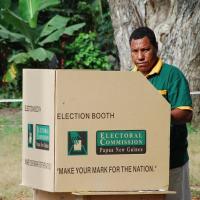The Voter’s Guide to LPV – How does it work?

Limited Preferential Voting, or LPV, was introduced in Papua New Guinea to achieve two basic objectives:
Firstly, voters everywhere want government services brought to them. MP’s elected into Parliament under First-Past-the-Post (FPP) were concentrating their efforts on the parts of the electorates that voted them in.
This meant that in some electorates where MP’s were voted in by as small as 10 per cent of the electorate vote under FPP (a common result), services were restricted to only those parts of the electorates. Other parts may not have seen services at all.
Secondly, voters with one vote under FPP were limited in their choice. With customary obligations often dictating how they exercised their votes, the opportunity for electors to vote for good leaders or the best leader, was restricted. Three vote preferences under LPV has given voters more choice.
Related to this were the negative social consequences of the limited choice voters had with one vote. In some parts of the country, disputes over who should be given the one vote resulted in conflicts within families, clans and tribes sometimes resulting in open violence.
Since 2007, we have seen a decline in the type of violence that marred the 2002 election in the five Highlands provinces of PNG. The provision of more choice provided under LPV has helped encourage cooperative behavior between rival clans and as a result, has helped preserve social harmony.
To fully appreciate how a person wins under LPV, one must bear in mind the objectives of LPV. Under both LPV and FPP, the candidate who receives the highest number of votes wins the election. The difference between the two relates to what constitutes ‘highest votes’.
Under FPP, the candidate who received the highest number of votes over other candidates won regardless of whether that number of votes was 5 per cent or 51 per cent of votes cast in the electorate. In an electorate where 35,000 voters voted, for example, a candidate could win with 2000 votes if there were 25 other candidates who scored less than 2000 votes. These votes are made up of the one vote from each voter, i.e. 2000 of the one vote.
Under LPV, the law requires that a winning candidate must get 50 per cent + 1 of the formal votes cast in the electorate. In an electorate where there are 35,000 votes, a candidate who receives 17,501 vote will win. Rules for counting votes enables this result to be achieved.
Understanding the counting rules will also assist in understanding how a winner is determined under LPV.
There are two distinct parts to counting votes under LPV. The first is the primary count. The 1st preference vote (i.e. Vote 1) is a voter’s primary vote and is counted first. The 1st preference votes of all voters are counted first, and at the end of this count, it must be determined if a candidate has received 50 per cent + 1 of the 1st preference votes to be declared winner.
If a candidate receives 50 per cent + 1 vote of the formal votes cast at this stage, the candidate is declared elected and there is no further count. In other words, a candidate who achieves this result wins by the 1st preference votes only. There is no need to count the 2nd or 3rd preferences (this count is done in the same way as the count done under FPP).
A candidate who is popular and is liked throughout an electorate, and is able to get the 1st preference votes of over 50 per cent can win with the 1st preference votes only. Such a candidate clearly has his/her electorate’s mandate.
Most electorates are likely to go into the second part of counting. This is the elimination part where, because no candidate receives 50 per cent + 1 of the 1st preference votes of all formal votes, candidates must be excluded from the count in order to re-distribute 2nd and 3rd preference votes.
The law says that the candidate with the lowest number of votes must be eliminated first, and votes that he or she received are to be redistributed to the remaining candidates according to the 2nd and 3rd preferences.
Therefore, where there are 20 candidates, after the primary vote count if no candidate receives 50 per cent + 1 of the formal votes, the candidate who received the lowest number of votes must be excluded. The votes allocated to him are redistributed to the 19 remaining candidates according to the 2nd preferences indicated on those votes.
After this first exclusion and re-distribution of the votes of the excluded candidate, it must be determined if the redistributed votes have given a candidate 50 per cent + 1 of the formal votes.
If a candidate does receive 50 per cent + 1 of the formal votes after the first exclusion, he/she will be declared. If not, the next exclusion must be done with the candidate with the lowest number of votes excluded, and his/her votes redistributed to the remaining 18 candidates according to the 2nd and 3rd preferences. This process continues until a winner is found — and a winner will always be found under this system.
However, some of the votes will run out of preferences, and are called exhausted votes. As more and more candidates are excluded, the chances increase for more and more votes to be exhausted. As more and more votes become exhausted, the ‘live’ formal votes remaining decrease. The 50 per cent + 1 wining margin is applied to the remaining ‘live’ votes, which necessarily become smaller and smaller.
This above explanation of LPV counting demonstrates a number of things.
Firstly, it demonstrates the importance of the 1st preference vote. It is possible for a candidate to win with first preference votes only. Therefore, candidates should seek the first preference vote.
However, as noted earlier, it is unlikely that in General Election 2012 candidates will win with 1st preference votes only (Peter O’Neill in Ialibu-Pangia will be the exception here). Therefore, 2nd and 3rd preferences will be critical for they will determine the winners in all other electorates.
But the 1st preference vote will be important for candidates to ensure that they are not excluded/eliminated early in the count. Elimination takes out a candidate from the race. If eliminated early in the count, all 2nd and 3rd preferences given to the eliminated candidate will not be counted.
Therefore, it is important for candidates to get enough 1st preference votes to stay in the race and collect 2nd and 3rd preference votes given to them.
For voters, this explanation demonstrates that 2nd and 3rd preference votes are as important as the 1st preference votes. The 1st preference votes will ensure that a candidate is not eliminated early, but it is the 2nd and 3rd preference votes which will determine a winning candidate.
Therefore, voters must value the 2nd and 3rd preferences as high as the 1st preference vote.
NOTE: This piece is based on an article published in the Post-Courier in 2007.













The objectives of the lpv have good intentions. However, we should ask wether the countng infringes on peoples constitional rights to elect their leader. The idea about exhausted votes n 2nd n 3rd preferences held at the top needs to be explored. We need to count all preferences n simply summed up to decide the winner.
‘Wesley Tsurumi’ – There is no doubt that LPV has improved upon FPP in the PNG context. Every electoral system has its faults, there is never a perfect one. In saying that, it’s important for us to be open-minded and choose an electoral system that fits.
I suggest Mixed Member Proportional (MMP) is a far better option for PNG than LPV. For some background reading on our electoral system, read this piece:
Rgds, Tavurvur.